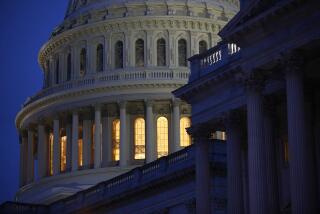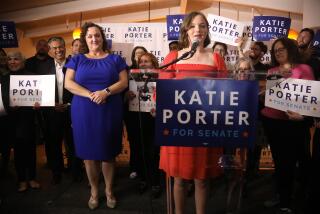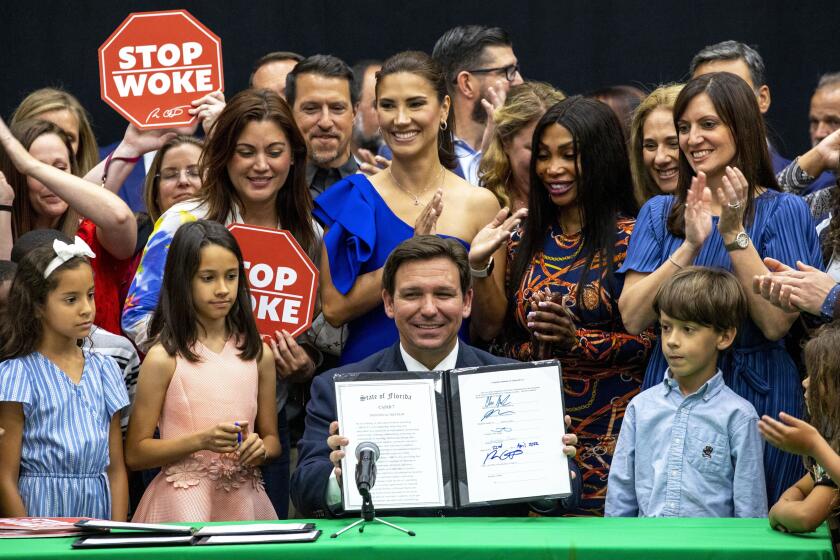Orange County congressional race between Rohrabacher and Rouda a dead heat, new poll finds

One of California’s most hotly contested congressional races — the campaign between incumbent Republican Rep. Dana Rohrabacher and his Democratic challenger, Harley Rouda — is starting off as a dead heat, according to a new poll that shows a Democratic edge on enthusiasm countering the Orange County district’s Republican leanings.
Rouda, who barely squeaked through the June primary to emerge as Rohrabacher’s opponent, has a 46%-43% edge among potential voters, the poll found — a nominal lead well within the survey’s margin of error.
The survey by Monmouth University is the first public, nonpartisan poll of the district since the June primary. The poll is one of a series that Monmouth, in West Long Branch, N.J., is conducting of key congressional races nationwide. The nonpartisan survey has compiled one of the country’s best records for accuracy in recent years.
Rohrabacher draws his strongest support from conservatives, fellow Republicans and white voters who did not graduate from college, a group that makes up just under one-third of the electorate, the poll found. Whites without college degrees favored Rohrabacher 55% to 34%, with 11% undecided.
Rouda gets his biggest backing from women, voters younger than 50 and non-whites, who make up about one-third of the electorate in the district, according to the poll.
But minority voters also showed somewhat less interest in the election than did whites, noted Patrick Murray, the director of the Monmouth poll. Just over half the nonwhite voters in the poll said they were following the congressional race “not too closely at all,” compared with 42% of whites without college degrees and 32% of whites who graduated from college.
“A key for Rouda is motivating this part of his base,” Murray said of the nonwhite voters surveyed.
About 35% of voters in the 48th Congressional District, which runs along the Orange County coast, are whites with a college degree. They divide evenly between the two candidates, the poll found.
Get the latest news from the nation’s capital on Essential Washington >> »
Rohrabacher has represented the region since 1988, when he left a job in the Reagan White House to run for Congress. He has seldom faced a significant challenge, but this year Democrats have targeted the district as part of their drive to win back control of the House.
Strategists in both parties, as well as nonpartisan handicappers, have rated the race as a tossup. The district has grown steadily less Republican and less conservative in recent years, and Rohrabacher’s statements in support of Vladimir Putin, as well as other controversial remarks, have alienated him from at least some GOP voters.
Rouda also benefits from a national climate that has boosted Democrats this year: Three-quarters of self-identified Democrats in the poll said they had “a lot” of interest in the congressional election, compared with 56% of self-identified Republicans.
The primary included multiple candidates from both parties, with Republican Scott Baugh, a former state legislator, giving Rohrabacher a stiff challenge. The incumbent took the top spot in the primary, with just over 30% of the vote. Rouda got the second spot on the November ballot by beating fellow Democrat Hans Keirstead by just 126 votes.
The poll found some signs of lingering divisions on the GOP side. Voters who identified as Democrats backed Rouda 95% to 2%, with 2% undecided. Self-identified Republicans were slightly less unified behind Rohrabacher at 85% to 5%, with 10% undecided. Independents backed Rouda 49%-31%, with 20% undecided.
About two-thirds of Democrats and independents who lean Democratic said they were satisfied with Rouda as their nominee, while 10% wished it were someone else. On the GOP side, 58% of Republicans and GOP leaners said they were satisfied with Rohrabacher, but 24% said they wished for a different candidate.
About one-third of voters said they had a favorable view of Rohrabacher, one third were unfavorable and a third expressed no opinion. Nearly all the poll’s interviews were conducted before publicity this week about Rohrabacher’s being interviewed by Sacha Baron Cohen for a satirical TV series in which the congressman appeared to voice support for the idea of arming kindergarten students for protection against school shooters.
Fewer voters had an impression one way or the other about Rouda: 27% said they viewed him favorably, 13% unfavorably, and 60% had no opinion.
Lack of knowledge about the challenger may matter less this year than normal, however. As is true in many congressional races around the country, opinions about President Trump may be driving the vote as much as any view of the candidates.
The district’s voters split narrowly on their view of Trump’s performance in office, with 46% approving and 49% disapproving.
Nearly 8 in 10 of Rouda’s voters strongly disapprove of Trump, while two-thirds of Rohrabacher’s voters strongly approve of the president’s job performance.
Voters split evenly when asked which party they preferred to have in control of Congress. That’s notable because registered Republicans outnumber Democrats in the district by 11 points.
About two-thirds of voters said it was important to them to cast a vote that expressed how they felt about Trump. The president’s opponents were slightly more likely than his supporters to feel that way.
The poll tested three voter turnout models, all of which yielded similar results. It defined “potential voters” as any registered voter who has voted in at least one election since 2010 or who is newly registered.
The second model, which looked at turnout consistent with recent averages, showed Rouda ahead 47% to 45%. He led 48% to 44% in the third model, which assumed a surge of voting in Democratic precincts.
The poll was conducted by telephone, using landlines and cellphones, from July 11-15, among 402 voters in the congressional district. The margin of error for the full sample is 4.9 percentage points in either direction.
For more on Politics and Policy, follow me @DavidLauter
More to Read
Get the L.A. Times Politics newsletter
Deeply reported insights into legislation, politics and policy from Sacramento, Washington and beyond. In your inbox three times per week.
You may occasionally receive promotional content from the Los Angeles Times.







